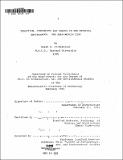| dc.contributor.advisor | Stanford Anderson. | en_US |
| dc.contributor.author | Al-Hathloul, Saleh Ali | en_US |
| dc.contributor.other | Massachusetts Institute of Technology. Dept. of Architecture. | en_US |
| dc.date.accessioned | 2009-08-26T16:20:13Z | |
| dc.date.available | 2009-08-26T16:20:13Z | |
| dc.date.issued | 1981 | en_US |
| dc.identifier.uri | http://hdl.handle.net/1721.1/46401 | |
| dc.description | Thesis (Ph.D.)--Massachusetts Institute of Technology, Dept. of Architecture, 1981. | en_US |
| dc.description | MICROFICHE COPY AVAILABLE IN ARCHIVES AND ROTCH. | en_US |
| dc.description | Bibliography: leaves 300-313. | en_US |
| dc.description.abstract | Issues within the context of the present cannot be isolated from their spatial or temporal context. Neither the past (tradition) nor the future (modern technology) can provide solutions to the problems of the present. Their value lies in the fact that they represent "resources" which broaden our choices and inform us as to how similar issues were or could be dealt with in different times and places. However, a society's past and the way that society conceives of its past provides modes of continuity which give the present its authenticity. If we are to deal with the issues of the present and hope for an authentic future, the authority of the past or tradition cannot be blindly accepted though its authenticity and relevance to the present must be recognized. The problem addressed here is that of a present physical environment in the Arab-Muslim city which is to tally different from the traditional one. As a result of this difference, a sense of discontinuity and alienation has developed among the inhabitants of these cities. The purpose of this study is to understand how this process came about and how a sense of continuity with the past can be reestablished. To achieve this purpose four main issues are addressed here: (l) the origin and process of formation of the traditional physical environment; (2) the disparity between the traditional and the contemporary environment; (3) the origins of this disparity; and (4) the possible notions which might be suggested by way of reestablishing a sense of continuity between the past and the present. The legal system is used as a means of analysis in this study. This has helped us to see the physical environment within its socio-cultural context, by informing us about the ideological or structural level of the society and by pointing out accepted social norms and conventions and the mechanism of their social effectiveness. The law has helped us to point out the differences between the traditional and the contemporary process. In the traditional city, the process relied on rules of conduct or social conventions which proscribed certain actions on the part of the inhabitants. In the contemporary city, the rules are physical and prescriptive in nature. They prescribe in physical terms not only what is to be done but also how it is to be implemented. Implied within the traditional process is a reciprocal and possibilist relationship between form and use while the contemporary process advocates a determinist approach to the relationship of form and use. Several factors are believed to have worked in favor of the shift from the traditional process to the contemporary one in the Arab-Muslim city. Important among these are: the existence of certain implied ideologies; changes in the scale of development, power and technology; and problems within the field of architecture and urbanism and their relationship to the Arab-Muslim context. Only by being aware of these processes and factors can we conceive of an appropriate approach to reestablish a sense of continuity with the past that sterns from the needs of the present and aspirations for the future. | en_US |
| dc.description.statementofresponsibility | by Saleh A. Al-Hathloul. | en_US |
| dc.format.extent | xiii, 335 leaves | en_US |
| dc.language.iso | eng | en_US |
| dc.publisher | Massachusetts Institute of Technology | en_US |
| dc.rights | M.I.T. theses are protected by
copyright. They may be viewed from this source for any purpose, but
reproduction or distribution in any format is prohibited without written
permission. See provided URL for inquiries about permission. | en_US |
| dc.rights.uri | http://dspace.mit.edu/handle/1721.1/7582 | en_US |
| dc.subject | Architecture. | en_US |
| dc.subject.lcsh | Islamic cities and towns | en_US |
| dc.subject.lcsh | Islamic architecture | en_US |
| dc.subject.lcsh | Islamic law | en_US |
| dc.title | Tradition, continuity and change in the physical environment : the Arab-Muslim city | en_US |
| dc.type | Thesis | en_US |
| dc.description.degree | Ph.D. | en_US |
| dc.contributor.department | Massachusetts Institute of Technology. Department of Architecture | |
| dc.identifier.oclc | 08176099 | en_US |
